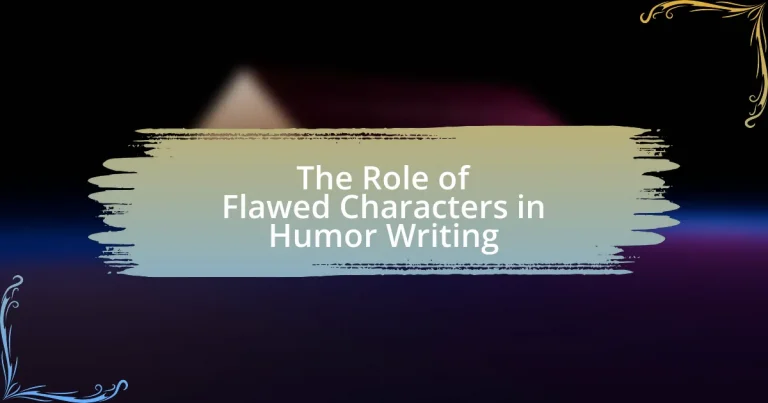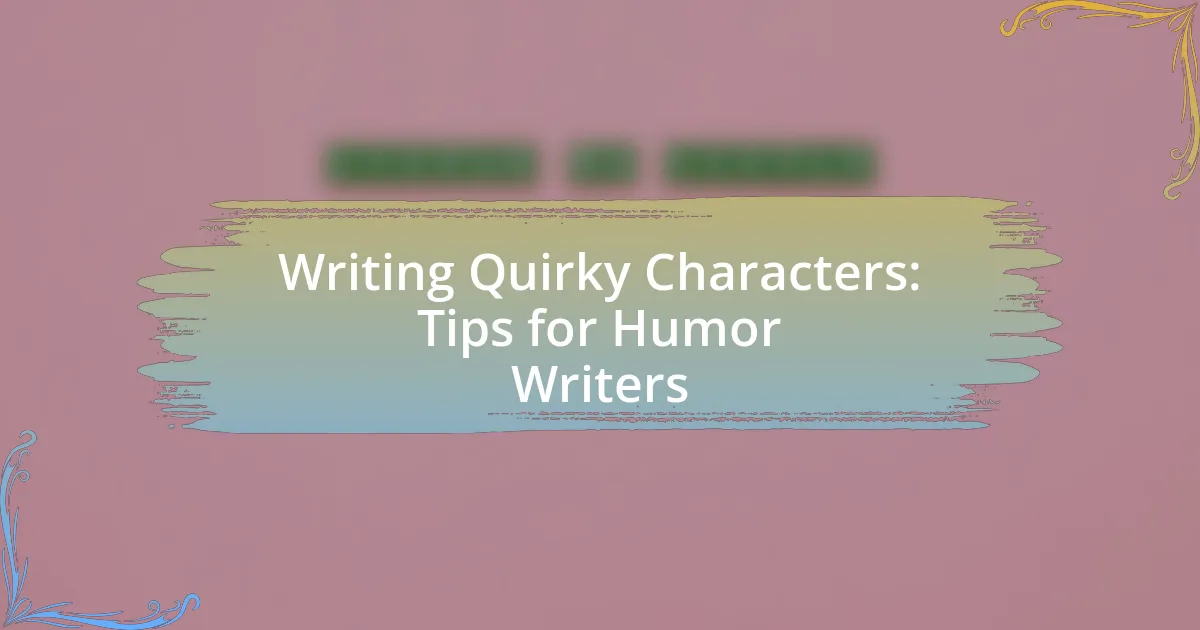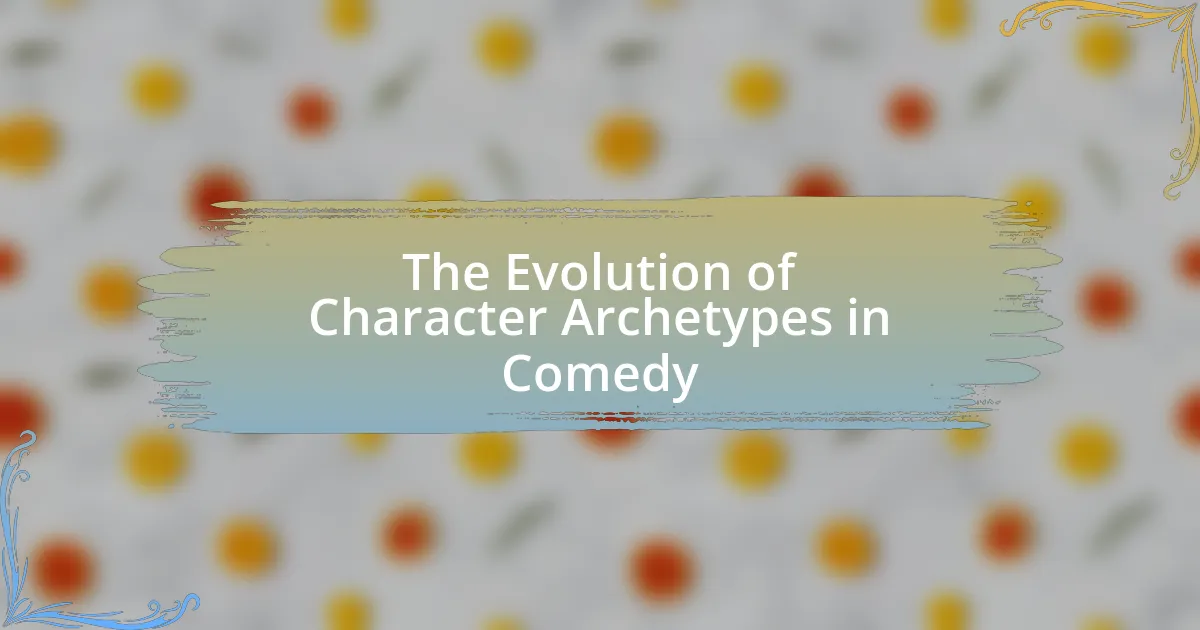Flawed characters are essential in humor writing, as they create relatable and authentic situations that resonate with audiences. Their imperfections often lead to comedic scenarios, allowing viewers to empathize with their misadventures while reflecting on their own flaws. This article explores how traits such as self-deprecation, absurdity, and exaggerated weaknesses enhance humor, the psychological effects these characters have on audiences, and the narrative techniques that amplify their comedic impact. Additionally, it discusses common types of flawed characters, the challenges of writing them, and practical tips for creating effective humor through flawed character development.

What is the Role of Flawed Characters in Humor Writing?
Flawed characters play a crucial role in humor writing by creating relatable and authentic situations that resonate with audiences. Their imperfections often lead to comedic scenarios, as these characters navigate challenges that highlight their shortcomings, making them more human and engaging. For instance, in sitcoms, characters like Michael Scott from “The Office” exemplify how flaws can drive humor through awkward social interactions and misguided decisions, which audiences find both amusing and relatable. This connection fosters empathy, allowing readers or viewers to laugh at the characters’ misadventures while reflecting on their own imperfections.
How do flawed characters contribute to humor?
Flawed characters contribute to humor by creating relatable situations and highlighting human imperfections. Their mistakes and shortcomings often lead to comedic scenarios that resonate with audiences, as people can see reflections of their own flaws in these characters. For example, in sitcoms like “The Office,” characters like Michael Scott exhibit social awkwardness and poor decision-making, which generates humor through their misguided attempts at leadership and relationships. This relatability fosters a connection with viewers, making the humor more impactful and engaging.
What specific traits make characters flawed yet humorous?
Characters are considered flawed yet humorous when they exhibit traits such as self-deprecation, absurdity, and exaggerated weaknesses. Self-deprecation allows characters to acknowledge their shortcomings in a light-hearted manner, making them relatable and endearing to the audience. Absurdity introduces unexpected and ridiculous situations that highlight the character’s flaws, creating comedic tension. Exaggerated weaknesses, such as clumsiness or naivety, amplify the humor by placing characters in situations where their flaws lead to humorous outcomes. These traits are effective because they resonate with audiences, as they reflect real human imperfections, making the humor more accessible and engaging.
How do these traits enhance comedic situations?
Flawed characters enhance comedic situations by creating relatable and exaggerated scenarios that highlight human imperfections. These traits often lead to misunderstandings, awkward interactions, and unexpected outcomes, which are essential elements of humor. For instance, a character’s overconfidence can result in a series of failures that are both amusing and insightful, as seen in classic sitcoms where characters frequently misjudge their abilities. This relatability allows audiences to connect with the characters, making the humor more impactful and engaging.
Why are flawed characters essential in humor writing?
Flawed characters are essential in humor writing because they create relatable and authentic situations that resonate with audiences. These imperfections often lead to comedic scenarios, as the characters’ mistakes and shortcomings can generate unexpected outcomes and laughter. For instance, in sitcoms like “The Office,” characters like Michael Scott exhibit numerous flaws, which not only drive the plot but also highlight the absurdity of everyday life, making the humor more impactful. This relatability fosters a connection between the audience and the characters, enhancing the overall comedic experience.
What psychological effects do flawed characters have on audiences?
Flawed characters evoke empathy and relatability in audiences, leading to a deeper emotional connection with the narrative. This connection often results in increased engagement, as viewers see their own imperfections reflected in these characters, which can foster a sense of acceptance and understanding of human fallibility. Research indicates that characters with flaws can enhance humor by creating situations that are both relatable and absurd, allowing audiences to laugh at the characters’ misfortunes while simultaneously feeling compassion for them. For instance, a study published in the Journal of Personality and Social Psychology found that audiences are more likely to enjoy stories featuring flawed protagonists because they mirror real-life complexities, making the humor more impactful and resonant.
How do flawed characters create relatability in humor?
Flawed characters create relatability in humor by reflecting the imperfections and vulnerabilities inherent in human nature. These characters often exhibit traits such as insecurity, clumsiness, or moral ambiguity, which resonate with audiences who recognize similar flaws in themselves. For instance, studies in psychology suggest that humor often arises from incongruity, where the unexpected behavior of flawed characters elicits laughter because it mirrors real-life situations that are awkward or embarrassing. This connection fosters empathy, as viewers see their own struggles and imperfections represented, making the humor more impactful and engaging.
What types of flawed characters are commonly found in humor writing?
Common types of flawed characters found in humor writing include the bumbling fool, the cynical skeptic, the overconfident braggart, and the socially awkward misfit. The bumbling fool often creates humor through their clumsiness and lack of awareness, leading to comedic situations. The cynical skeptic provides humor through their sarcastic observations and disbelief in the absurdity around them. The overconfident braggart generates laughter by exaggerating their abilities, often leading to embarrassing failures. The socially awkward misfit elicits humor through their inability to navigate social norms, resulting in awkward and funny interactions. These character types are effective in humor writing as they highlight human imperfections, making them relatable and entertaining.
What are the characteristics of the ‘lovable loser’ archetype?
The ‘lovable loser’ archetype is characterized by a combination of endearing qualities and consistent failures. This archetype often embodies traits such as optimism, resilience, and an inherent charm that makes them relatable to audiences. Despite their shortcomings, lovable losers typically maintain a positive attitude and a sense of humor about their misfortunes, which enhances their appeal.
For example, characters like Charlie Brown from the Peanuts comic strip exemplify this archetype; he faces repeated disappointments yet remains hopeful and kind-hearted. This blend of vulnerability and perseverance allows audiences to empathize with their struggles, making them memorable and engaging in humor writing.
How do ‘the cynic’ and ‘the naive’ serve comedic purposes?
The cynic and the naive serve comedic purposes by creating contrasting perspectives that highlight absurdities in human behavior. The cynic often provides a skeptical viewpoint that critiques societal norms, leading to humor through sarcasm and irony, while the naive character embodies innocence and ignorance, resulting in comedic situations due to their misunderstandings and literal interpretations. This dynamic creates a comedic tension where the cynic’s jaded outlook clashes with the naive’s optimistic simplicity, allowing audiences to laugh at the folly of both perspectives. For example, in literature and film, characters like the cynical detective and the naive sidekick often find themselves in humorous predicaments that expose the ridiculousness of their surroundings, effectively using their flaws to elicit laughter.
How do flawed characters interact with other elements of humor writing?
Flawed characters enhance humor writing by creating relatable situations and driving comedic conflict. Their imperfections often lead to misunderstandings, awkward scenarios, and exaggerated reactions, which serve as a foundation for humor. For instance, in sitcoms, characters like Michael Scott from “The Office” exemplify how flaws can lead to cringe-worthy yet hilarious moments, making audiences empathize with their struggles while laughing at their missteps. This interplay between character flaws and humor elements, such as timing and situational irony, amplifies comedic effect, as seen in various comedic literature and television shows.
What narrative techniques enhance the humor of flawed characters?
Narrative techniques that enhance the humor of flawed characters include exaggeration, irony, and self-deprecation. Exaggeration amplifies the flaws of characters, making their shortcomings more pronounced and thus more humorous; for example, a character who is overly clumsy can lead to comedic situations that highlight their ineptitude. Irony creates humor by presenting a contrast between expectations and reality, such as a character who believes they are a great chef but consistently burns their meals. Self-deprecation allows flawed characters to acknowledge their shortcomings in a humorous way, making them relatable and endearing to the audience. These techniques are effective because they not only highlight the flaws but also invite the audience to laugh at the absurdity of the situations, reinforcing the comedic value of the characters.
How does irony play a role in the portrayal of flawed characters?
Irony significantly enhances the portrayal of flawed characters by highlighting the contrast between their self-perception and reality. This dissonance often leads to comedic situations, as characters may believe they possess qualities such as intelligence or morality, while their actions reveal the opposite. For example, in literature and film, a character who prides themselves on being a great leader may consistently make poor decisions, creating humor through their misguided confidence. This technique not only elicits laughter but also invites the audience to reflect on human imperfections, making flawed characters relatable and engaging.
What role does exaggeration have in developing flawed characters?
Exaggeration plays a crucial role in developing flawed characters by amplifying their shortcomings, making them more relatable and humorous. This technique highlights the absurdity of their flaws, allowing audiences to connect with the characters on a deeper level. For instance, a character with an exaggerated fear of commitment may lead to comical situations that reveal their vulnerability, ultimately making them more endearing. Research in humor theory, such as the Incongruity Theory, supports this by suggesting that humor arises from the unexpected contrasts between a character’s exaggerated traits and their circumstances, enhancing the comedic effect.
What are the challenges of writing flawed characters in humor?
Writing flawed characters in humor presents the challenge of balancing relatability with absurdity. Flawed characters must resonate with audiences to elicit laughter, yet their imperfections can lead to unlikability if not handled carefully. For instance, a character’s selfishness may be humorous in a specific context but can alienate the audience if overemphasized. Additionally, humor derived from flaws must avoid reinforcing negative stereotypes, as this can result in backlash and diminish the comedic effect. The challenge lies in crafting these characters to ensure their flaws contribute to humor without overshadowing their redeeming qualities, thus maintaining audience engagement and empathy.
How can writers avoid making flawed characters unlikable?
Writers can avoid making flawed characters unlikable by ensuring that these characters possess redeeming qualities or relatable motivations. By giving flawed characters depth, such as vulnerabilities or a sense of humor, writers can create empathy in readers. For instance, a character who struggles with selfishness but shows moments of kindness can resonate with audiences, as they reflect real human complexities. Research indicates that characters who exhibit a mix of flaws and virtues are often more engaging, as they mirror the multifaceted nature of real people, making them relatable and less likely to be perceived as entirely negative.
What balance should be struck between flaw and charm?
A balance between flaw and charm should emphasize relatable imperfections while maintaining endearing qualities. Flawed characters resonate with audiences because they reflect real human experiences, making them more relatable and engaging. For instance, a character’s clumsiness can evoke humor, but if paired with a genuine kindness or loyalty, it enhances their charm. Research indicates that characters who exhibit both flaws and redeeming traits are often more memorable and impactful in storytelling, as they create a dynamic that fosters empathy and connection with the audience.
What practical tips can writers use to create effective flawed characters in humor writing?
Writers can create effective flawed characters in humor writing by ensuring that these characters possess relatable imperfections that lead to comedic situations. Flaws such as clumsiness, overconfidence, or social awkwardness can generate humor when they result in unexpected outcomes or misunderstandings. For instance, a character who is overly confident in their cooking skills might create a disastrous meal, leading to humorous interactions with others. Additionally, writers should develop these flaws in a way that allows for growth or self-awareness, as this can enhance the comedic effect while making the character more relatable. Research indicates that characters with depth and complexity, including flaws, resonate more with audiences, making the humor more impactful.





